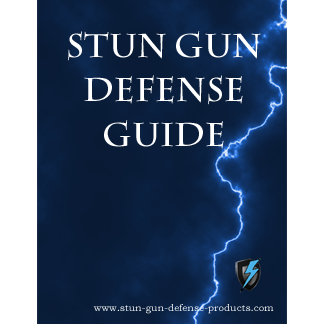TASER Questions

- Is the Taser a firearm?
No, Taser Electronic Control Devices (ECDs) are not considered firearms by the U.S. Bureau of Alcohol, Tobacco, Firearms, and Explosives (BATF) because the Taser cartridge uses compressed, inert nitrogen gas to launch the probes instead of gun powder.
- How does a TASER work?
TASERs work by firing two pronged darts which are propelled by compressed nitrogen. The darts are tethered to insulated copper wire which conduct the electricity from the TASER into the attacker’s body. When both darts hit, if the electrical circuit is completed and maintained, it may cause the attackers muscles to contract and they may lose voluntary muscle control.
- What is the difference between a Taser and a stun gun?
A Taser is far more powerful than a traditional stun gun. First, it can incapacitate an attacker from up to 15 feet away while a stun gun requires direct contact with the threat. This gives you a zone of protection other self-defense options cannot offer. Second, unlike stun guns, Taser technology does not rely on pain compliance localized to the point of contact; rather it affects the sensory and motor functions of the nervous system and inhibits muscular control. This keeps an attacker down and immobilized for 30 seconds not just "stunned" for as long as you maintain contact. However, a Taser can also be used as a direct contact stun device if necessary.
- What is the difference between a civilian-grade Taser and police-grade Taser devices?
The civilian-grade device uses the same exact technology and offers the same stopping power as the police version. There is a difference in the cycle time - the Taser Pulse+ relays the charge for 30 seconds compared to 5 seconds with the police version. This is so you can keep your attacker down and get yourself to safety. The shooting distance is also different, the Taser shoots 15 feet, while police-grade Taser devices can shoot upwards of 30 feet.
- Are there any special requirements or permits I need to own a TASER?
Most states have no special requirements or permits that are need for possession. It is legal to own a TASER in the U.S. except in HI, RI, Chicago, IL, Denison/Crawford County, IA and USVI. (We do not ship to MA). View State TASER Laws for more information. Some states do require permits to carry the Taser on your person outside of your home or business (please contact your local authority for your states specific laws concerning concealed carry).
- Why do I have to pass a felony background check to own an Taser in Maryland, Minnesota, and Illinois?
State law requires passing a background check in these areas. Background checks take around 48 hours to receive results and are processed on business days only. Monday - Friday, 9am - 5pm.
- To purchase a Stun Gun, do I need to pass a felony background check?
No, a background check is not required to purchase a stun gun. Stun Guns are restricted in some states and cities, read our State Stun Gun Laws for more information.
- What is it like to shoot a Taser? Do I need special training?
When shot, there is no recoil or kick like when shooting a firearm. Special training is always a good idea for any self defense option, most importantly you must understand how it works and how to operate it safely and effectively. User training manuals are available for each Taser model on our Taser User Manuals Downloads page. User manuals cover everything you need to know about your device including instruction on operating your device, how to insert and eject firing cartridges, how to replace batteries or power magazines, how to open the safety cover, how to aim, where to aim, how to fire, and what to do in the event of an emergency. It is also beneficial to practice shooting the Taser in order to get comfortable with it. You can also view Taser Pulse+ Training Videos for further Pulse+ training.
- What is it like to be shot by a Taser?
Different people have different reactions, but it’s definitely uncomfortable. Some people compare it to touching a live electrical outlet except that it’s not localized to the point of contact; it has more of a full body effect where muscular control is limited for the duration of the charge cycle. It can be describe as muscle lock up because you are generally unable to move. The NMI effect is not about pain compliance, but incapacitation in order to keep someone down and away from you. That said, it is generally mildly to moderately painful.
- Does it cause permanent injury?
Think of the NMI effect as a light switch, it’s either completely on or completely off. During the shock cycle, the sensory and motor function signals are confused, which inhibits muscular control and causes incapacitation. Once the charge cycle ends, sensory and motor functions resume normally and allow signals to be transmitted to the muscles - the NMI effect is off. Taser ECDs are not risk-free, however, as injuries can result from falls, drug/alcohol-related complications, or other external circumstances.
- Can the Taser be quickly accessed to defend myself?
It’s as simple as point and shoot. Tasers are designed to provide you an option that is effective yet easy to access and use. The safety switches are simple to operate and ensures that the ECD is not accidentally fired. The laser sight lets you aim accurately and feel confident that you will make contact with an attacker. The trigger is a simple pull mechanism that allows you to fire, drop the device, and run while the attacker continues to be shocked.
- Do the probes need to hit a specific area to be effective?
Aim to “Split the belt.” The LASER indicates the area where the top probe will make contact. The bottom probe may make contact below the top probe. The top probe should be aimed in the lower center mass or abdomen area. The bottom probe should strike in the thigh area. Try to avoid the head, neck, and genital area if possible.
- Are the firing cartridges reuseable?
Each cartridge can only be fired once but can deliver multiple electrical cycles. That means that while the darts can only be projected at a target once, as long as the darts remain in the target after the initial 30-second electrical cycle (30-seconds for the Pulse+ and 5-seconds for the X2 and X26), subsequent electrical cycles can be engaged.
- What do I do if the darts miss?
All TASER weapons are equipped with a back-up stun gun feature. In the event that the user misses with the probes, the TASER can still be used as a stun gun even with spent cartridge still in device (or after it is removed of course).
- Can I buy cartridges that have wires longer than 15 feet?
No. Civilians may only purchase 15-foot cartridges. Only Law Enforcement agencies can buy cartridges of other lengths.
- Are devices rechargeable?
No. The Taser Pulse+ uses replaceable Lithium batteries and the Taser X26 and X2 use replaceable power magazines, however the batteries provide enough energy for many uses before needing to be replaced.
- Do I need to register or activate my device?
No. All new devices come pre-registered to the purchaser. Just be sure to keep a copy of your receipt or other proof of purchase. All new TASER devices come pre-activated. Only older models of the TASER C2 may need to be activated. This can be determined by examining the LED light located beside the button trigger which can be revealed by sliding back the safety cover. If the LED light is GREEN, the device is already activated. If the light is RED, the device needs to be activated. Email team@taser.com with your serial number and that your device needs to be activated for fastest response.
- What happens when I defend myself with my Taser and have to leave it behind? Will it be replaced?
Tasers are designed with your safety in mind. Upon firing and striking your attacker, the Taser Bolt and Taser Pulse deliver 30 seconds of electric energy into the attacker's body giving you time to drop the device and get to safety while the attacker is still being shocked. All aser devices come with a Safe Escape Product Replacement Guarantee in the U.S. If you ever have to use your Taser to defend yourself and must leave it behind, the manufacturer, Axon, will replace it free of charge once you've sent a police report of the incident.
- Will the Taser Bolt fire accidentally? Should it be carried in a special case or holster?
The Bolt was designed to balance accessibility with safety. You need to be able to reach and fire it quickly if necessary, but also feel confident that it won’t be accidentally discharged. For this reason, the push button trigger is located beneath a safety cover that must be slid all the way open before the Bolt can be fired. A holster is not necessary although they are easily accessible. The Bolt can be carried safely and discreetly in a pocket, purse, handbag, brief case, or just about anywhere. It’s important that you are comfortable carrying it and that its readily accessible should you need it.
- How long will the battery last for? Is it rechargeable, or can I use regular batteries?
The Lithium Power Magazine can supply over fifty 30-second applications. As with all power sources, environmental conditions, such as extreme heat or cold, can impact battery life differently. The Lithium Power Magazine (LPM) is not rechargeable. Replacement LPMs are available for purchase.
- How safe is it to have around children?
Tasers are self-defense devices, and like other options, should be kept out of reach of children at all times. They are equipped with a safety features to avoid accidental discharge, but should always be stored in a safe place away from children.
- How big is the Taser Bolt and what does it weigh?
The Bolt only weighs about seven ounces and measures about 6 inches long.
- Can Tasers be brought on a plane?
Taser devices are not permitted in carry-on luggage for domestic U.S. flights. However, they can be packed in checked baggage if you are traveling to a state that allows possession. Federal law prohibits carrying or shipping Taser devices out of the U.S. so international flight restrictions apply.






